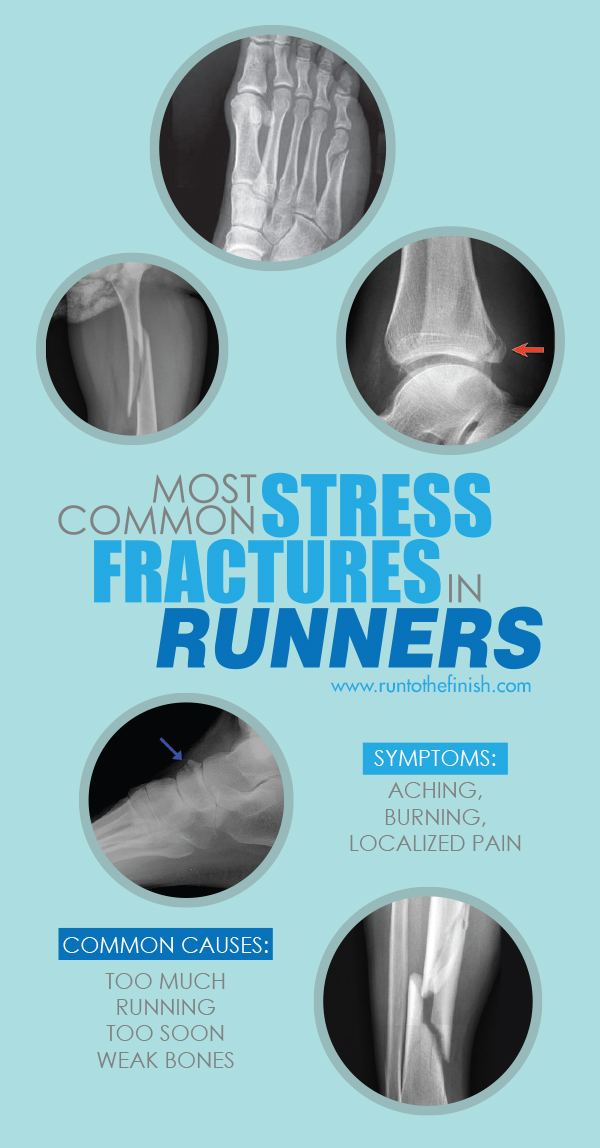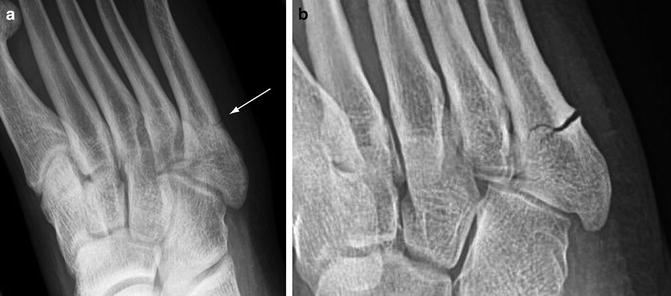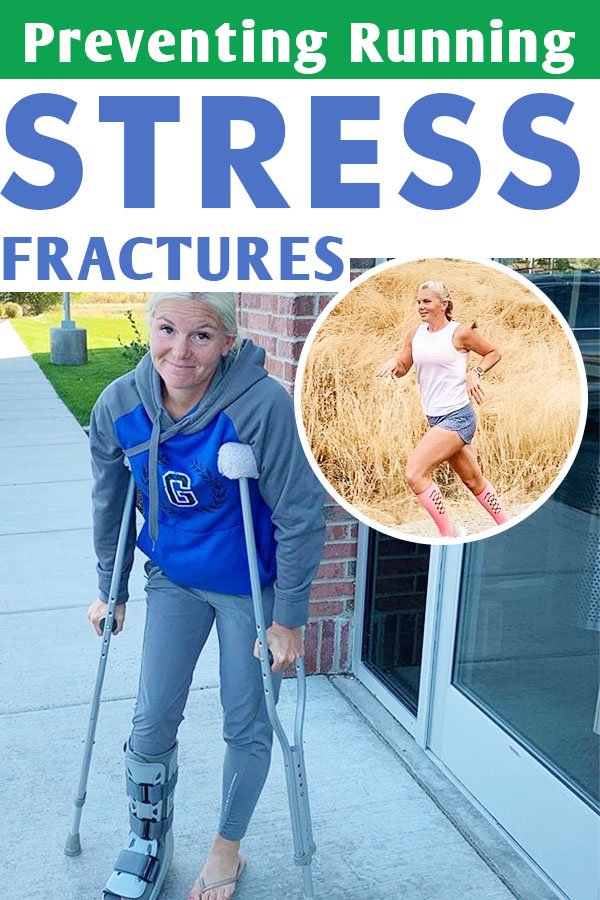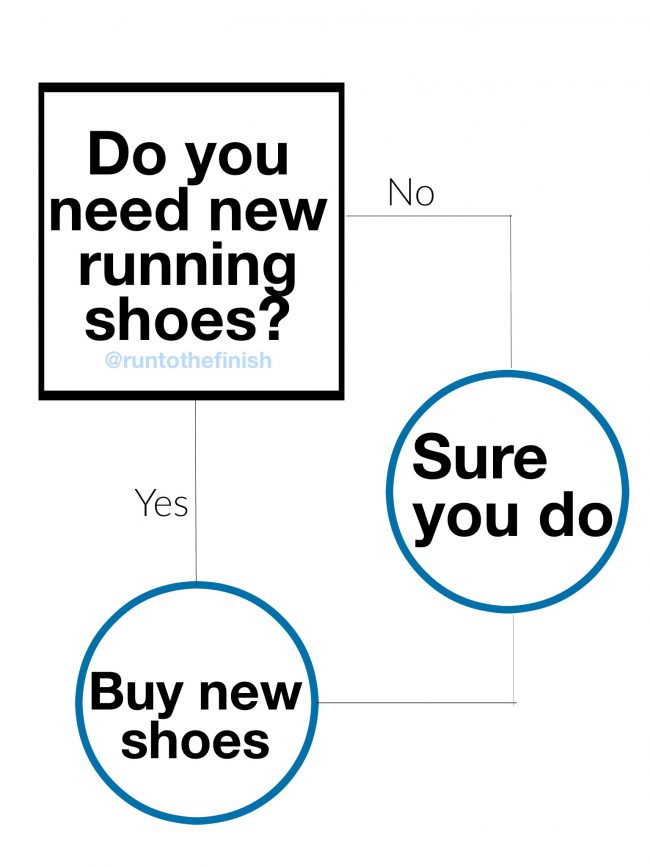A few weeks ago on Facebook I asked what injury had taken you out of the running game and I was blown away at the number of people who said running stress fracture! Not only that, but how many reported having multiple stress fractures.
Like any good journalist my interest was peaked and the research began!
I quickly realized that this is one of the most common and frustrating injures among runners (right alongside the IT band). Unfortunately the female athlete triad or other nutritional issues are one of the big causes…but not the only.
What is a Stress Fracture?
According to the Mayo Clinic: Stress fractures are tiny cracks in a bone. Stress fractures are caused by the repetitive application of force, often by overuse — such as repeatedly jumping up and down or running long distances.
Stress reaction: Bone is breaking down and becoming weak, but has not broken (usually minimum 3-4 weeks non-running exercise)
Stress fracture: A fissure has occurred in the bone, might need a boot for stabilization (usually 6-8 weeks non-running exercise)
It appears that many doctors will use the two interchangeably, though they are different! I think this is largely to ensure you understand that the bone needs rest and because they can’t say this chronic and repetitive bone stress.
This is not to say that running will always lead to stress fractures. They are indeed preventable in most cases!
The most common running stress fractures are to the tibia, metatarsals (the foot bones), fibula and femur. The second and third metatarsals of the foot, receive the greatest impact when you push off to walk or run and thus are very common.
Basically the lower leg, which is absorbing so much of the impact from each foot strike. And becomes weakened with underfueling and overtraining.
Most stress fractures are treated non-surgically. Which means the recovery process is largely in your smart hands.
What Does a Stress Fracture Feel Like?
This is something many runners have wondered when they start to experience foot pain. Could it be a tendon, a bruise or is it a stress fracture?
When it comes to a stress fracture, the most notable symptom is localized pain that gets worse with running over time.
Meaning, you might notice a little something at a specific spot in your foot/ankle/shin/hip and think nothing of it, but over the course of a few weeks the pain keeps getting worse and worse every time you run.
When you can pinpoint the pain, and the pain is on a bone, a stress fracture is definitely a possibility.
- Try backing off for a few days.
- If you return without pin pointed pain, it may have been a tight or overworked muscle.
- If not, then go get an x-ray – ASAP. It’s better to catch it as a fracture before you turn it in to a full break.
- A break will require more time to recover and stress fractures don’t magically heal by ignoring them.
Here are other common running foot pains if you still aren’t sure.

7 Keys to Running After a Stress Fracture
Running after a stress fracture is a difficult process for a lot of reasons that go well beyond the physical.
The array of emotions many runners will feel as they get back into the sport can be all over the map:
- Worried about the potential of re-injury
- Discouraged over potentially losing fitness
- Excited to be running again
Whatever emotions you’re dealing with, remember that getting back into running after a stress fracture isn’t as easy as lacing up your shoes and heading out the door.
The first few times out after being cleared to run after a stress fracture can be tough for a few reasons:
#1 Phantom Pains After Stress Fracture
You will feel just about everything going on within your body, and you’ll be worried that each of them is a new injury!
Trust me, you’re fine.
- focus on your breath
- take in the scenery
- enjoy the fact that you’re running
- try not to be paranoid about every little sensation
#2 Go Short, Go Slow
This can be tough, but you really do have to ease back into running slowly. Remember, your stress fracture developed over many miles, and if you try to do too much too soon there’s a good chance that you can cause the stress fracture to come back!
- keep your first runs short (and short is relative, it depends on how long you’ve been out and what your mileage was like before the injury)
- ensure your intensity is low (again, relative)
- allow your body to re-adapt to the demands of running (act like a beginner!) – all of your joints, muscles and tendons need that time
- seriously act like a beginner, use run/walk, follow the Couch to 5K plan if you need guidelines
#3 Work Through Mental Fears of the Loss of Fitness
If your running stress fracture had you out for awhile, you very well may have lost some of the fitness that you worked so hard to build over the past weeks/months/years.
Hopefully you’ve been doing a lot of cross training while you were healing, but we all know that getting out and going for a run is just different, and if you haven’t been able to run for awhile it can be frustrating to feel like you’ve lost ground.
- For the first several runs after coming back from a stress fracture, just enjoy the fact that you are running again and that you can do so without pain.
- Remember that you will regain fitness faster than the first time you tried to get there because your body and mind know what is possible.
- Checkout this full guide on how much fitness you lose with time off
Over the next several weeks you’ll be able to work back to where you were pre-injury, and as hard as it can be to stay patient that’s the best thing you can do to prevent another stress fracture.
#4 Pre-Hab and Re-hab Like It’s Training
I cannot emphasize enough to work with a Sports focused Physical Therapist. A general PT is focused on simply getting you walking pain free, a sports PT wants you to run strong and get back out there 100% as quick as possible.
Once they assign you PT exercises, do them.
Sounds obvious, but I’m serious. If they give you 5 exercises to do 3 times a day, do it! These movements are not just going to help with the recovery process, but will prevent future running injuries.
Don’t be afraid to ask your PT what you can do. Can you bike, can you swim, can you yoga? Find out the limitations and then STICK TO THEM!
Rushing the recovery isn’t worth the setback.
#5 Strength Train Consistently
We know that running is good for our health and our bones, but strength training is the other thing that’s a must for strong bones!
According to multiple studies, strength training places a stress on the bone which tell the bone to build mass even in those with osteoporosis!
While you are waiting to place weight on your injured leg, start weight training with your upper body and core. That’s right, it’s going to help as well! Strength training for runners helps with endurance, improves posture, improves speed and will help prevent other injuries.
Once you are ready to start adding strength to the leg again, work with that PT to get guidelines.
- Start with body weight only movements
- Consistently utilize single leg movements, this will help ensure your stronger leg doesn’t compensate after injury
- Add in mini-bands
- Finally you MUST lift weights – the studies show the bone building occurs from lifting heavy things, not just your body weight.
#6 Focus on Inflammation Reduction
During the recovery process there are going to be aches as the body adapts to getting back to the intensity of running. Our goal is to both help the body adapt and relieve the mental fears from soreness.
Some inflammation is required after a workout to produce results.
BUT chronic inflammation from high stress or pain, we want to control without using NSAID’s.
- Herbs For Muscle Recovery – easy things you can add like tea to feel good
- Anti-inflammatory Meals – Foods that are going to assist in recovery
- CBD Oil for Runners – This was a game changer for me after knee surgery. Maybe largely because it improves sleep.
#7 Return to Running Program After Stress Fracture
This is not a time to wing it, like we might do with some races. You want to follow a truly structured plan to return to running and keeping it pain free.
Phase 1
- Eliminate all weight bearing activities until cleared by your Doctor
- Start doing the strength training for upper body and core immediately
- Ask if you are cleared to do Aqua Jogging or Pool Running – this is a phenomenal way to keep your fitness and will be really useful during the rebuild
Phase 2
- Begin doing cross training like a stationary bike, rowing or swimming once cleared
- Continue doing strength training, only start adding in any lower body approve by Physical Therapy
- If there is pain, stop, reverse and go back to phase 1.
Phase 3
Now it has probably been 6-8 weeks and you’re ready to officially start running.
- Start with a short 20 minute run/walk session
- After every session evaluate any appearance of pain and go back to phase 2 if it appears
- Continue walking daily and slowly increase the number of runs each week
- Then slowly increase the volume of time running vs walking
- Don’t add speed work back to your plan until you have at least a few months of completely pain free running
After all of this, read on for the must do’s to prevent any future stress fractures from running!!
Speaking of preventing a stress fracture in your foot from running…
How to Prevent Running Stress Fracture?
Assuming that you’re going to keep running, and that the running caused the stress fracture in the first place, is it just a matter of time before you’re dealing with the same problem again?
No!
Not every injury, stress fracture included, can be prevented but there are certainly things you can do to minimize your chances of getting another stress fracture (or getting your first one, if you’ve never had one before).
1. Increase Mileage Slowly
The rule of thumb is to increase total mileage by no more than 10% per week, but coming off of a stress fracture you’d be wise to be even more conservative for the first month or two.
Yeah, it might be frustrating to progress at such a slow rate, but it beats no running at all because of another stress fracture!
2. Mix Up Running Surfaces
Running on asphalt or concrete is harder on your body than running on trails or grassy fields.
A running surface that has a little more give to it will lessen the stress on your body, and can decrease your odds of developing a stress fracture.
3. Get Off the Treadmill
I really hate running on the treadmill, but I know some people like them and that’s fine. {Amanda’s Note: yup love mine!!!}
Believe it or not, there can be a link between treadmill running and stress fractures.
When you’re running on the treadmill, your feet contact the deck of the treadmill pretty much exactly the same every step. If you’re running on any other surface, you’re going to get slight variations with how your feet hit the ground due to changing surfaces, turns, topography, and a whole host of other variations.
Why does this matter?
When your feet are hitting the ground slightly different with every step (and we are talking about differences that are almost impossible to perceive, but bear with me) the point of maximal stress on your bones is different with each step.
But on the treadmill, you’re landing the same way virtually every time your foot hits the deck and focusing the force on the same area over and over. So if you have the option to get outside or run on an indoor track instead of a treadmill, do it!
4. Check Your Shoes
When was the last time you got a new pair of kicks? As your shoes break down, so does their ability to provide cushioning when you’re running.
Typically, a good pair of running shoes will last between 300-500 miles, but the durability varies from runner to runner and shoe to shoe.
Another good idea is to rotate multiple pairs of running shoes, especially if you’re running several days a week. Shoe rotation has several benefits, one of which is that it allows the foam to fully decompress before you wear them again so you get maximal shock absorption.
You may also want to have the running store look at your shoes to see if there are any noticeable wear patterns that would indicate you are rolling your foot, which would lead to extra stress on the body.
5. Focused Sports Nutrition
A stress fracture is a breaking down of your bones, so how can you help improve the strength of your bones so they won’t break down due to the stresses of running?
Making sure you get enough calcium is an obvious answer, and a good one, but it’s not the only ingredient your body needs to strengthen your bones.
Did you know that if you have a Vitamin D deficiency, your body actually can’t absorb the calcium needed to build stronger bones? So make sure you’re getting enough Vitamin D, whether that’s through diet, supplementation, sun exposure, or all of the above.
- Underfueling will weaken bones
- Being low in minerals will weaken bones (not just calcium)
A calcium deficiency (either through inadequate intake or improper absorption), the body will pull calcium from bones in an attempt to maintain balance.
When there’s too much of this borrowing, along with increased stress on the skeletal system from running, the result may be significant bone loss. This can lead to increasingly weak bones and tada you’ve gotten to the stress fracture.
6 tips to prevent one of the most common #running injuries, stress fractures!! from @dizruns and @runtothefinish Click To Tweet6. Listen To Your Body
Honestly, the best way to prevent a stress fracture is to simply listen to your body. Our bodies are great at telling us that something is wrong, we just tend to be terrible at heeding the warnings and backing off to allow the body the ability to heal itself.
Stress fractures are no fun, that much is obvious. But there are things you can do to dramatically reduce your chances of developing a stress fracture and being forced to take a running break.
So listen to what your body is telling you, increase your training volume intelligently, and give your body the fuel it needs and you’ll be giving yourself the best chance of enjoying pain-free miles for years to come!
Have you ever had a stress fracture?
What other running injuries do you need info on?
Click here to visit his website.
Other ways to connect with Amanda
Instagram Daily Fun: RunToTheFinish
Facebook Community Chatter: RunToTheFinish
Sign Up to Receive a Weekly Newsletter with Top Running Tips and Laughs







 Hanson Marathon Method Overview and Real Experiences
Hanson Marathon Method Overview and Real Experiences
vitatrain4life
Luckily I've never had one but this is great information!
My recent post The Rundown – Roll With It
Diz Runs
Glad you haven't had to deal with a stress fracture before, because they are definitely no fun!
SuzLyfe
I'm coming back right now, and I'm dealing with the fear! I can coach others through it, but when you stress fracture a bone in your back, and it really sidelines you in such a significant way, you truly are frightened. I'm hoping to start testing the waters again this coming weekend. I've done some mini runs (like a couple hundred feet), and I still feel something–not pain, just not right–so I'm just going to take my time.
My recent post SoulCycle x Target, Blends, and Blog Inspiration Weekend
Diz Runs
It's tough to stay patient, but it's definitely the best bet. Hope you're back to running (Pain Free!) soon!
My Healthyish Life
I had a metatarsal stress fracture in October and it took me until the beginning of this year to start running again. I can completely attest to all of these feelings! Especially the fear over re-injury. It's been a slow and steady return to running, with some steps forward and steps backward.
My recent post Whole30 Week 4: Let’s Finish This
Diz Runs
Best of luck as you continue to move forward from you injury!
wendy
I've had a few stress fractures in my feet. One was due to arthritis in my big toe. My coach works with me on hip strengthening to help me (among other things) from landing so hard on the inside of my foot. It really is all in the hips, isn't it?
My recent post Big Sur Marathon Training– Week 1
Diz Runs
No joke Wendy, it really is all about those hips!
Megan
I had two stress fractures two years ago then after being recovered for 7 months was in a car accident and broken my tibia. The struggle is real! But I've managed to maintain my fitness through swimming, cycling and weight lifting. I'm only now just beginning to test the waters with treadmills and stairclimbers.
My recent post Healthy Chocolate Berry Bars {GF, Paleo, Vegan}
Diz Runs
Oh man! Hope your rash of bad injury luck is behind you for good now Megan!
Laura
This is such an important topic! I agree that nutrition is a really key component- I’ve dealt with a few stress fractures and I link it back to my vegetarian years when my protein (and therefore iron, calcium, Vitamin D, magnesium, etc) was much lower than it should have been. That’s not to say that you can’t do it right on a vegetarian diet, but I wasn’t paying as much attention to getting all those nutrients as I was to avoiding meat and my body was thrown off by it. I’ve been healthy and strong since adding in whole food supplements, more meat and training smart.
Diz Runs
Nutrition and rest are so often overlooked when it comes to a variety of injuries, stress fractures definitely among them. Glad you've find a nutrition strategy that works for you!
mapsley
Unfortunately I have. And the worst part is the fear of doing it again. Most common injuries/aggravations for me are tendonitis type things and muscle strains. I have a hamstring that just doesn't like speed work, and it drives me nuts! It seems speed work aggravates any type of injury. I guess a good topic for more info might be: How can I get benefits of speed work without re-injuring or aggravating?
My recent post Experiencing God….Anywhere
RunToTheFinish
Speed work is an injury cause for so many, I'll definitely tackle that soon!!!
Diz Runs
Speed work is such a slippery slope because there are SO many benefits to doing it yet if you are really pushing hard you are toeing the line of injury with every workout. One way to get some of the benefit without as much of a risk of injury is to do longer intervals which will require to you run a bit slower but still pushing you outside of your comfort zone. Think 800m/mile repeats instead of 400m repeats. Yes, the longer repeats may not technically qualify as "speed" but you've got to weight the pros and cons.
underseamd
I've had a lot of issues with my IT band recently.. Hopefully it's on the mend, now, though!
My boyfriend has had a seasamoid bone stress fracture though, and his doc basically banned him from running for life. =\
My recent post Review: HASK Monoi Coconut Oil Hair Care
Diz Runs
That sucks for your BF! (And for you too, hope you're ITB is feeling better ASAP.) A sesamoid bone stress fracture is tough. Not sure it would require a "no running again ever" diagnosis though. Might want to encourage him to check with a sports med doc/pediatrist that has experience working with runners. There may need to be some serious modifications made, but I'd think he could still do some running if he wanted.
mkadens1
Knock wood, I've avoided stress fractures so far. I'm more of a muscle strain kind of girl. I agree with Mapsley above that speedwork makes my high hamstrings angry.
My recent post Training Ups and Downs
Diz Runs
There's definitely no good type of injury, but I'll take a strain over a stress fracture any day of the week and twice on Sundays!
thisrunnersrecipes
I'm knocking on wood right now because I've never had a stress fracture. These tips were helpful to read for making sure I don't ever have one – I really need to start varying my training surfaces more!
My recent post Mile Markers: Lake Sammamish Half Marathon Training Week 8
Diz Runs
Definitely hope that the suggestions help you stay stress fracture free! I know some people, especially non-runners, think that if you run you're destined to deal with a stress fracture, but that really isn't the case. Happy running!
rosedaughter1427
I've had an actual avulsion fracture, which put me off running for 6 weeks! It was just about agony to be stuck in the pool aqua-jogging or standing on the sidelines while coaching a cross country team! I agree with everything you say above, and in fact recommend that you get a physical therapist to address any biomechanical imbalances and really rein you in from re-injuring yourself. My physical therapist had to put up with 3 weeks of "Can I run yet?", but once I was cleared to run, I was allowed to run 2 miles every other day. Make no mistake about it, I had all sorts of phantom pains in my foot, and I felt so out of shape, but I was just glad to run again. The next week, I progressed to 3 miles; the week after that 4; and then 5 miles. By the 5-mile mark, I was allowed to resume base-building mileage (20-ish mph), gradually ramp the distance up over the next 2 weeks, and heck, even throw in 1 day of "easy" fartleks. I am very grateful that I took things slowly, as now I can run completely injury-free.
Diz Runs
Glad you're back to being pain free! There's nothing worse than rushing yourself back from an injury, and then ending up injured again because of it! It's better to take your time, recovery completely, and build back slowly even though it's super difficult to be so patient.
My recent post Join Me at the Connect Run Club Virtual Running Summit
Diz Runs
Thanks for checking out the post. Prevention is always easier than treatment, that's for sure!
My recent post Join Me at the Connect Run Club Virtual Running Summit
Benjamin
I have a question, I’m coming back from a tibial stress fracture in my right leg that happened on December 4th during an APFT. Tomorrow I have to take another APFT but when I run, even when it’s just a few hundred meters, I still have the pain that feels like a bad shin splint in both legs. How can I combat this and should I be worried about the pain that I am still feeling?
Amanda Brooks
Thanks for the great article, I’m currently waiting to hear back from an MRI to determine whether I have a stress fracture in my foot.
I just want to go running and have resorted to purchasing loads of new running gear ready for when I’m back on the road :@) Retail therapy and physiotherapy helps lol
Gene
Thanks for the great info. I am recovering from a stress fracture in my knee (chondyle). I have a great doc (former doc for the Indianapolis Colts who is know the team doc for Xavier University's basketball team) who diagnosed me through x-rays and MRIs. He said I had no other damage in the area surrounding the stress fracture. I spent 6 weeks on crutches, and moved into physical therapy. I would expect plenty of muscle soreness from the therapy because of the weakness that developed. What I didn't expect (and I am still experiencing) is the significant lingering tenderness in the knee area. My doc says the bone has healed (as of the end of February), but I am still limping in the end of April. My therapist seemed surprised to learn of this. Nobody can answer the question about when the soreness in the knee joint will dissipate, but it keeps me from even trying to run because I end up limping after a two mile walk.
Rachel
This was actually a really good article on the subject. Very helpful. Thanks so much!
Last November I found out I had multiple stress fracture in the pubic ramus area. I started running again in February but it’s been a struggle. I’ve started having pain again so I’m going in to get an X-ray.
The doctor gave me a 2 month healing time but it was 3 months before I was even able to run. When I look at other people’s experiences with the same injury, it usually takes 5-6 months to heal, sometimes years. It’s really discouraging.
RunToTheFinish
Ahh hope the xray is nothing!! Stay positive, it might be slow but you can definitely come back!
Val
I have a stress Fracture on the Third metatarsal bone on my foot. Do you reccommend going to a Physical Therapist?
amanda
oh gosh, I’m not a doctor so I’d hate to give you the wrong info!! I would say that for me with any major injury, at least one visit to the PT has always helped me learn new exercises which make me a stronger runner and hopefully prevent that injury from happening again.
Val
Okay thanks! And ive been resting for about 4 weeks already and I just want to get back to running and playing soccer so bad, but i know i have to be patient. Do you know how long it takes for a stress fracture on the Third metatarsal on my foot to heel???
suguna
hi. i am recovering from stress fracture neck of femur. i am an ultra trail runner who just ran too much too fast. i just graduated from no weight bearing to partial weight bearing. the pain, physical and psychological is real.
i look forward to walk again in a couple of weeks.
…to run again….probably another 6 months.
Janice
This is a very thorough article. Resting or night pain can also be associated with a stress fracture. If a stress fracture is present it may not show on xray until 2-4 weeks post injury, and a bone scan may be warranted. Successful management of a stress fracture allows the bone adequate time and rest to heal (4-8 weeks) but maintains strength and conditioning in the individual, and addresses any factors in their training/lifestyle that may predispose them to these injuries.
Deirdre
Just seeing this article. I am into my 3rd week of no running. But have been pool running and spinning like crazy to ensure return to competition fitness. I have not had scan, so not sure it is a fracture. But certainly some overuse injury to metatarsal, due in part to too much high intensity. You know that supposed 85/15: easy/hard split… Well, in thinking I was invincible, I did it in reverse. Bad idea! Hoping, to ease back into light running within next 2 weeks, and be back fighting fit for 2018 season.
I definitely recommend the pool running. There is a great sense of reassurance doing an activity that closely mimics land running.
Emma @ MenstrualCupaholic.com
Great post, much needed. I only started running last year and have been on and off with it. Because I don’t do it often enough, I think I sometimes push myself too much and then end up taking a very long break due to injury or fatigue.